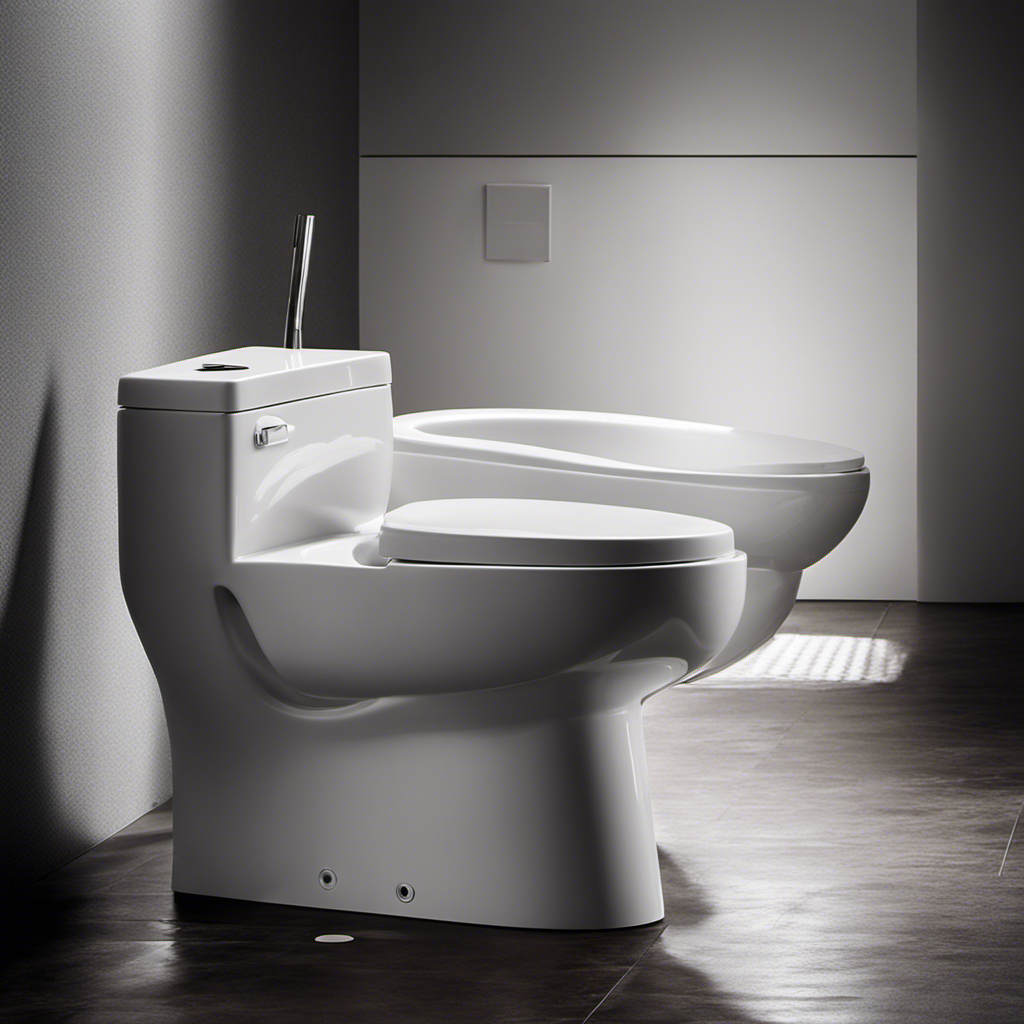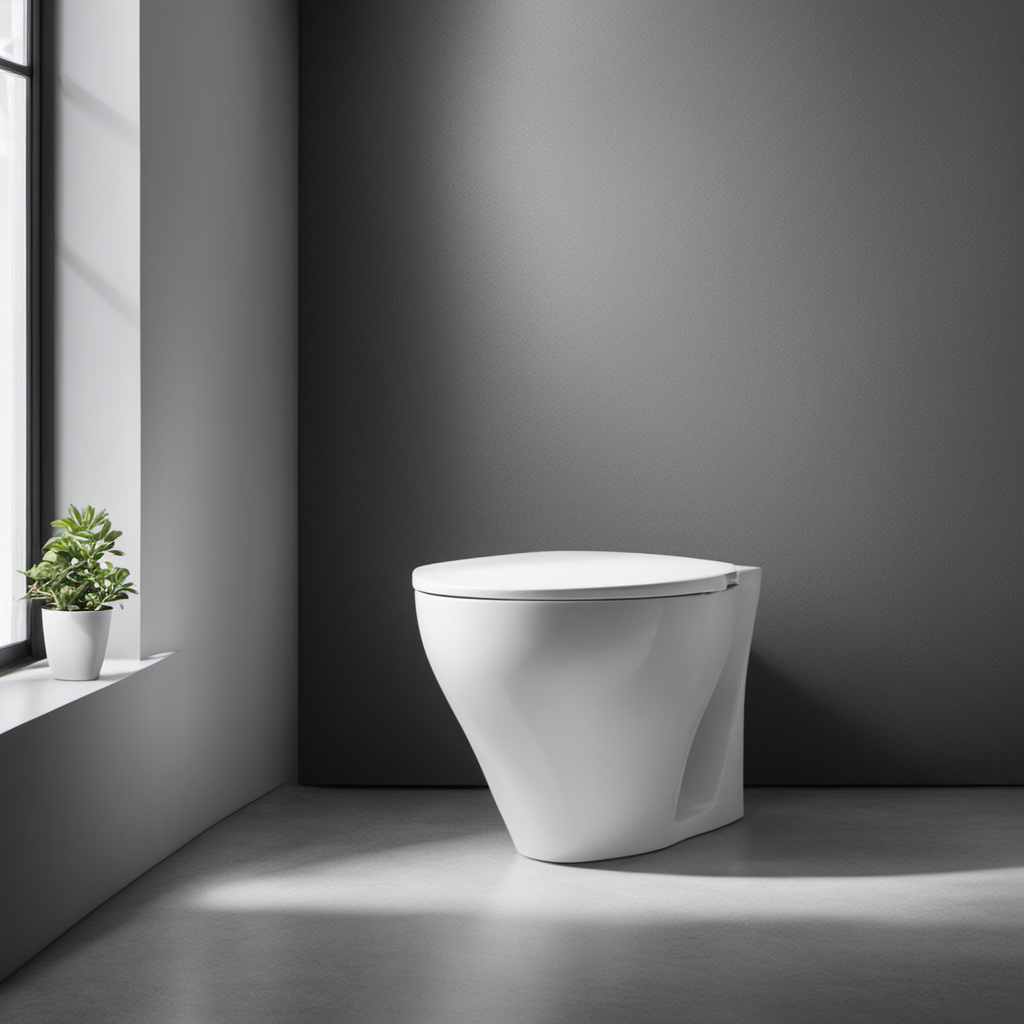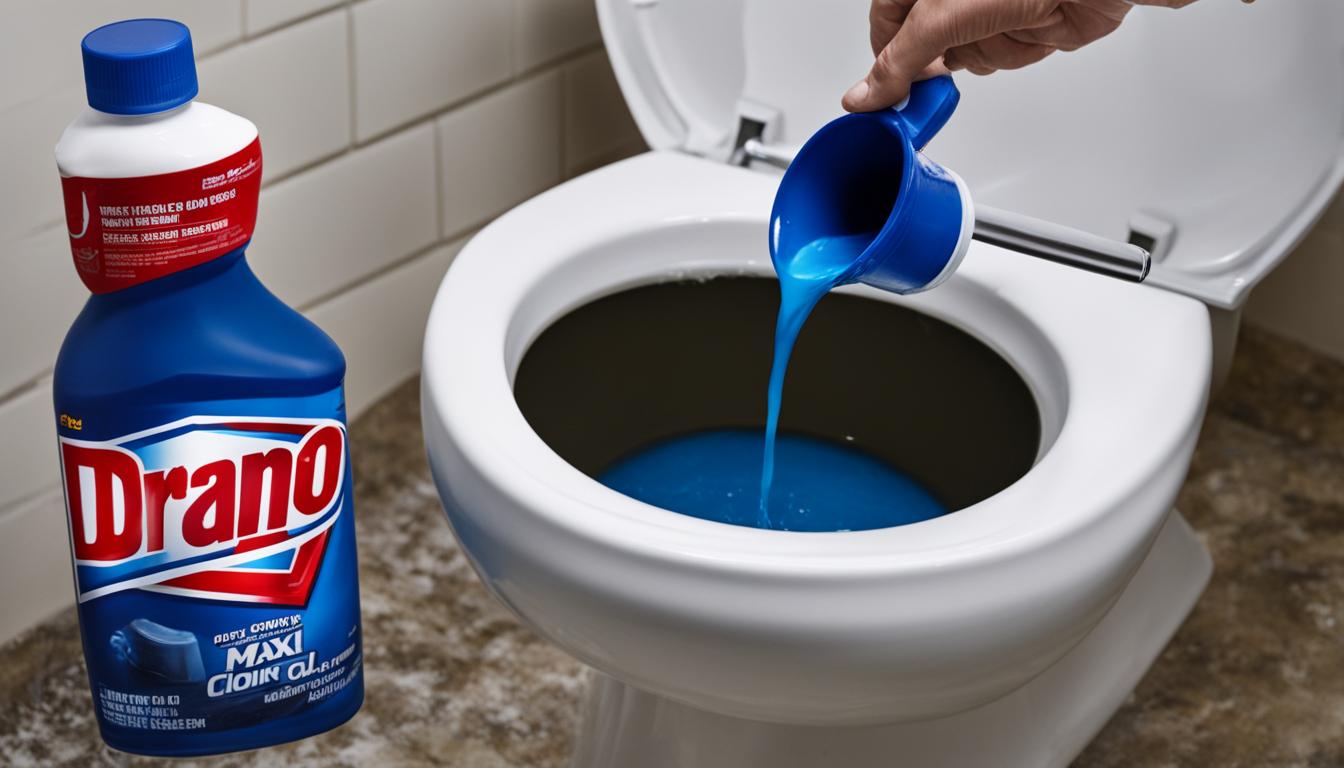Have you ever wondered why your toilet is draining slow? Well, I’ve got the answers for you!
In this article, I’ll be explaining all the potential blockages and faults that could be causing this frustrating issue.
From a faulty flapper to a clogged vent pipe, I’ll break down the technical aspects of your plumbing system and provide practical solutions to get your toilet flowing smoothly again.
So, let’s dive in and solve this slow-draining problem once and for all!
Key Takeaways
- Clogged pipes and a blocked vent stack are common causes of slow toilet drainage.
- Using a plunger or drain snake can help dislodge clogs and improve drainage.
- Checking the water supply valve for partial closure and adjusting the water level can address low water pressure issues.
- Regular preventive maintenance, including inspecting and replacing the flapper valve, can prevent slow-draining problems in the future.
Potential Blockages
You might have a potential blockage causing your toilet to drain slow. There are several factors that can contribute to this issue.
One common cause is a clog in the pipes leading from the toilet bowl to the sewer line. This can happen when foreign objects or excessive amounts of toilet paper accumulate in the pipes, obstructing the water flow.
Another possible culprit is a faulty flapper valve. This valve is responsible for controlling the release of water from the tank into the bowl, and if it is not functioning properly, it can restrict the water flow and lead to slow drainage.
Additionally, a blocked vent stack can also cause slow-draining toilets. The vent stack is a vertical pipe that allows air to enter the plumbing system, and if it becomes blocked, it can disrupt the water flow and cause drainage problems.
To resolve these issues, you can try using a plunger to dislodge any clogs, or you may need to snake the drain to remove the blockage. Checking the water supply valve is also important, as it could be partially closed and limiting the water flow.
Lastly, regular preventive maintenance, such as avoiding flushing foreign objects and periodically cleaning the toilet bowl, can help prevent future slow-draining problems.
Faulty Flapper
If you’re experiencing a slow-draining toilet, one potential culprit could be a faulty flapper valve. A plumbing expert would explain that the flapper is responsible for regulating the flow of water from the tank to the bowl during flushing. Common flapper problems include wear and tear, improper alignment, or a buildup of mineral deposits.
To troubleshoot the slow drain, a professional plumber might suggest inspecting the flapper for any signs of damage or deterioration, and if necessary, replacing it with a new one to restore proper flushing and drainage.
Flapper Replacement Necessary
To fix the slow drainage of your toilet, replacing the flapper is necessary. The flapper is a crucial component in the toilet tank that controls the flow of water into the bowl. Over time, the flapper can become worn or damaged, resulting in leaks and inadequate flushing. There are various types of flappers available, including rubber and silicone options. It’s important to choose the right type of flapper for your toilet to ensure a proper fit and function. Here is a table that outlines the different types of flappers and their characteristics:
| Flapper Type | Material | Features |
|---|---|---|
| Rubber flapper | Rubber | Affordable and widely available |
| Silicone flapper | Silicone | Longer lifespan and durability |
Common Flapper Problems
One common flapper problem is when it becomes warped and doesn’t create a proper seal. This can lead to a slow-draining toilet.
As a plumbing expert, I would explain that a faulty flapper valve is just one potential issue that could cause a toilet to drain slowly. Other factors may include clogged pipes or a blocked vent stack.
To address this problem, I would recommend using a plunger to try and clear any blockages. If that doesn’t work, snaking the drain with a drain auger could help remove any obstructions. Additionally, checking the water supply valve to ensure it’s fully open is important.
Regular toilet drain cleaning can also help prevent future issues. By following these steps, you can resolve the slow-draining toilet problem efficiently.
Slow Drain Troubleshooting
You can troubleshoot a slow drain by checking for any blockages or obstructions in the pipes. One possible cause is clogged pipes, which can be caused by a buildup of debris or foreign objects. Another potential issue could be a faulty flapper valve, which may not be sealing properly and allowing water to slowly leak out. Additionally, a blocked vent stack could be restricting the flow of air and causing the drain to be slow.
To address these issues, you can use a plunger to dislodge any obstructions, or use a drain auger to break up and remove clogs. Checking the water supply valve and ensuring proper water pressure can also help resolve the problem. Regular toilet maintenance, such as cleaning the flapper valve and checking for any leaks, can help prevent future slow-draining issues.
Clogged Vent Pipe
When it comes to a slow-draining toilet, one potential cause could be a clogged vent pipe. The vent pipe plays a crucial role in the plumbing system, allowing air to enter and prevent suction that can hinder drainage.
If the vent pipe becomes blocked, it can lead to negative pressure in the pipes and result in slow toilet drainage. To resolve this issue, a plumbing expert may recommend using a drain auger or professional snaking services to clear the clog and restore proper ventilation.
Additionally, they may suggest preventive maintenance, such as regular inspections and cleaning of the vent stack, to avoid future clogs and ensure efficient toilet drainage.
Causes of Clogged Vent
If your toilet is draining slow, it could be due to a clogged vent. A clogged vent can cause air pressure issues in your plumbing system, leading to slow or incomplete drainage.
Here are some potential causes of a blocked vent:
- Debris buildup: Over time, leaves, dirt, and other debris can accumulate in the vent pipe, obstructing the flow of air.
- Animal nests: Birds or small animals may build nests in the vent, causing an obstruction.
- Ice or snow: In colder climates, ice or snow can accumulate in the vent, restricting airflow.
- Structural damage: Cracks or collapses in the vent pipe can also lead to blockages.
To resolve a clogged vent, it’s important to locate the obstruction and remove it. This may involve using specialized tools or calling a professional plumber to address the issue.
Regular maintenance, such as checking and cleaning the vent, can help prevent future problems.
Effects on Toilet Drainage
To improve toilet drainage, ensure that the vent is free from obstructions and the airflow is unrestricted. When the vent stack is blocked, it can cause negative pressure in the drainage system, leading to slow toilet drainage. The vent stack is a vertical pipe that allows air to escape from the plumbing system, preventing vacuum and ensuring smooth drainage. If the vent stack is clogged, it can result in air being unable to escape, causing water to drain slowly. Additionally, a blocked vent stack can lead to sewer gas buildup, resulting in unpleasant odors in your bathroom. It is important to regularly inspect and clean the vent stack to maintain proper airflow and prevent slow-draining toilets. If you are unsure how to do this, it is recommended to seek professional plumbing services for assistance.
| Potential Causes of Slow-Draining Toilets | Solutions |
|---|---|
| Clogged pipes | Use a drain auger or plumber’s snake to remove the blockage. |
| Faulty flapper valve | Replace the flapper valve with a new one. |
| Blocked vent stack | Clear the vent stack of any obstructions. |
| Low water pressure | Check the water supply valve and ensure it is fully open. |
| Wax ring damage | Replace the wax ring to create a proper seal. |
Regular toilet maintenance and timely plumbing services can help prevent slow-draining toilets and ensure the proper functioning of your plumbing system.
Solutions for Clog
Ensure that you regularly inspect and clean the vent stack to prevent clogs in your plumbing system.
When it comes to a slow-draining toilet, there are several potential issues that could be causing the problem. Here are some common culprits to consider:
- Clogged pipes: Over time, debris and sediment can accumulate in your pipes, restricting water flow and causing slow drainage.
- Faulty flapper valve: If the flapper valve in your toilet tank is not functioning properly, it can lead to incomplete flushing and slow drainage.
- Blocked vent stack: The vent stack allows air to flow into the plumbing system, which helps with proper drainage. If it becomes blocked, it can cause the toilet to drain slowly.
- Low water pressure: Insufficient water pressure can result in poor flushing and slow drainage.
To address a slow-draining toilet, you can try using a plunger, snaking the drain, or checking the water supply valve.
Regular maintenance and cleaning can help prevent future clogs and ensure proper drainage.
Low Water Level
Check if the water level in your toilet is low. Low water level in a toilet can be a common cause of slow draining. When the water level is low, it can affect the toilet’s flushing power and cause a slow drain.
There are a few factors that can contribute to low water level in a toilet. One factor is toilet water pressure. If the water pressure is too low, it can result in inadequate water flow and a low water level in the toilet bowl. Another factor is the shape of the toilet bowl. Some toilet bowl shapes are designed in a way that may cause water to drain slowly.
To address the issue of low water level, you can try adjusting the water supply valve to increase the water level. If that doesn’t work, it may be necessary to consult a professional plumber to diagnose and resolve the problem.
Malfunctioning Flush Valve
The malfunctioning flush valve can cause issues with my toilet’s flushing power and water level. There are several potential issues that could be causing my toilet to drain slowly:
- Clogged pipes: Blockages in the sewer lines can restrict the flow of water, leading to slow drainage.
- Faulty flapper valve: If the flapper valve is not sealing properly, water may continuously leak into the bowl, reducing the flushing power.
- Blocked vent stack: A blocked vent stack can prevent proper air circulation, affecting the flushing performance.
- Water supply valve: If the water supply valve is not fully open, it can reduce the water pressure and result in a weak flush.
To address the slow-draining issue, I can try the following solutions:
- Plunger: Using a plunger can help dislodge any clogs and restore proper drainage.
- Snaking the drain: Using a drain auger or snake can help remove stubborn blockages.
- Check the water supply valve: Ensuring that the water supply valve is fully open can increase water pressure and improve flushing power.
- Consider flush valve replacement: If the flush valve is faulty, replacing it can restore proper flushing performance.
Damaged or Blocked Drainage Pipe
If your toilet is still draining slowly after checking the flush valve, the next potential culprit could be a damaged or blocked drainage pipe. A damaged pipeline can restrict the flow of water, causing the toilet to drain slowly. Additionally, a blocked drainage pipe can prevent waste from flowing freely, leading to a slow-draining toilet.
To diagnose this issue, a plumbing expert would first visually inspect the drainage pipe for any visible damage or blockage. They may also use a drain auger, a flexible tool that can help remove obstructions from the pipe.
If a damaged pipeline is identified, repairs or replacement may be necessary. This could involve excavating the affected area and installing new pipes.
To prevent future slow-draining toilet problems, it is important to avoid flushing items that can cause blockages, such as wet wipes or excessive toilet paper. Regular maintenance, including periodic drain cleaning, can also help keep the drainage system in good condition.
The table below summarizes the potential causes and solutions for a slow-draining toilet:
| Potential Causes | Solutions |
|---|---|
| Clogged pipes | Use a plunger or drain auger to remove the obstruction. Avoid flushing large amounts of paper or non-flushable items. |
| Faulty flapper valve | Replace the flapper valve if it is not sealing properly. |
| Blocked vent stack | Clear the blockage or contact a professional plumber to resolve the issue. |
| Damaged or blocked drainage pipe | Visually inspect the pipe for damage or blockage. Use a drain auger to remove obstructions. Repair or replace the damaged pipe if necessary. |
Frequently Asked Questions
How Can I Determine if My Toilet’s Flapper Is Faulty?
To determine if your toilet’s flapper is faulty, first, remove the tank lid and flush the toilet. If the flapper doesn’t close properly or water continues to run, it may need to be replaced.
What Are the Signs of a Clogged Vent Pipe in a Toilet?
If you’re wondering about signs of a clogged vent pipe in a toilet, there are a few indicators to look out for. To unclog a vent pipe, you can use a drain auger or call a professional plumber for assistance.
How Can I Increase the Water Level in My Toilet Tank?
To fix a running toilet and increase water level, check for low water pressure in the tank. The issue could be caused by clogged pipes, a faulty flapper valve, or a blocked vent stack. Try using a plunger or snaking the drain.
What Are the Common Symptoms of a Malfunctioning Flush Valve in a Toilet?
When troubleshooting toilet flushing problems, diagnosing flush valve issues is important. Common symptoms of a malfunctioning flush valve include weak flushes, incomplete flushing, and slow drainage. It may be necessary to repair or replace the flush valve to resolve the issue.
How Can I Identify if My Toilet’s Drainage Pipe Is Damaged or Blocked?
First, check for any visible blockages in the toilet bowl or drain pipe. If none are found, try using a plunger to clear the blockage. If that doesn’t work, consider calling a plumber to inspect and fix any common toilet drainage issues.
Conclusion
In conclusion, if you’re wondering why your toilet is draining slow, there are several potential causes to consider. It could be due to blockages in your pipes, a faulty flapper valve, a clogged vent stack, low water level, or a malfunctioning flush valve.
Remember the old saying, ‘An ounce of prevention is worth a pound of cure.’ By practicing regular maintenance and addressing any issues promptly, you can prevent future slow-draining toilet problems.
If you’re unsure or need assistance, it’s always best to consult a professional plumber who can provide accurate diagnoses and recommend the appropriate solutions.










